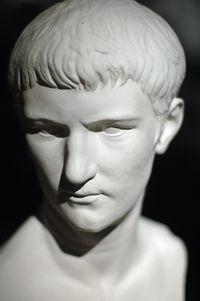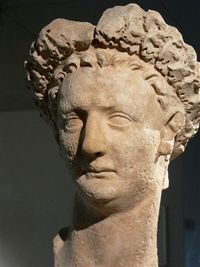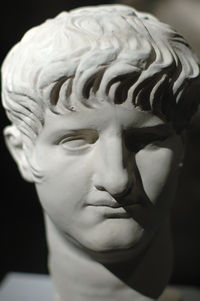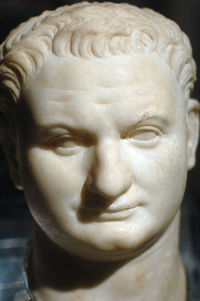Roman Emperor
Emperors
Augustus Caesar (r. 27 B.C.-14 A.D.)
Following the assassination of Julius Caesar on March 14, 44 B.C. Octavian the grand nephew and adopted son of Julius Caesar, Marc Antony, a Roman consul and Marcus Aemilius Lepidus, a high-ranking Roman official who had served under Julius Caesar, formally constituted a three-man ruling body, referred to as a triumvirate, to take Caesar’s place. They fought Caesar’s assassins, defeating Brutus and Cassius at the Battle of Philippi in 42 B.C. and executed Cicero. Octavian learned of his adoption while he was out of the country and after Julius Caesar's death. He eventually won acceptance into Caesar's family and inherited his estates, then changing his family name of Julius Caesar's and became known as Augustus.
In or sometime before 14 B.C., at the age of 76, Augustus had an account of his deeds, accolades and his expenditures recounted and later posted on markers in various parts of the Empire upon his death. With regard to the events following the assassination of Julius Caesar, the account simply says he freed the state from a faction, was named propraetor, consul and a triumvir in his 19th year (or 20th) and punished the assassins who slaughtered his father and defeated them in two battles.[1][2][3][4]
The triumvirate ruled more or less without crises for five years. However, the seeds of discord, arguably sown during the few months following Caesar’s death, between Antonius and Octavian,[5] lent impetus to the eventual disintegration of the three-man government which was renewed once and then came to an end with the defeat and death of Antonius and the exile of Lepidus.
Octavian, Augustus Caesar, took the throne in 27 B.C. During his forty-year rule he began building the political structure for Imperial Rome. The system of magistracies was subsumed by the throne and were awarded by the emperor (princeps in Latin).
Caesar Augustus also took over direct control of the majority of the provinces, ruling through his appointed subordinates, and nationalised the army, placing it under direct control of the emperor. This measure stripped generals of the power to interfere in politics with their troops in support as had been done earlier by Julius Caesar in 49 B.C..
Augustus invested heavily in changing Rome’s physical stature with extensive building projects to ostentatiously advertise his rule. Concomitantly, he went to great lengths to promote his own family as the future imperial dynasty.
When Augustus died in 14 A.D., he was succeeded by his step-son Tiberius.
Tiberius (r. 14-37)
Gaius Caesar "Caligula" (r. 37-41)
Gaius Caesar Germanicus, commonly known as Caligula, was Roman Emperor from A.D. 37 to 41. Born in A.D. 12, he was aged 24 when he succeeded Tiberius as Emperor. Four years later he was the victim of a political coup and was assassinated. The surviving ancient literature is united in its judgement of Caligua as a mad tyrant, however modern scholarship has questioned whether he really was insane and has refuted some of the more outrageous stories about his reign.
Claudius (r. 41-54)
Nero (r. 54-68)
Nero Claudius Caesar Augustus Germanicus, commonly referred to as Nero, was Roman Emperor from A.D. 54 to his death in A.D. 68. His mother married the Emperor Claudius in A.D. 49 and the following year the Emperor adopted Nero as his son. On Claudius' death in A.D. 54 Nero was proclaimed Emperor by the Praetorian Guard, becoming the youngest Roman Emperor in history. His mother was influential in ensuring Nero succeeded Claudius, though he later had her murdered.
One of the most famous events of Nero's reign was the Great Fire of Rome in A.D. 64. The city was devastated by the fire, and in the aftermath Nero cleared some of the damaged areas to built his Golden Palace. The expensive building was unpopular at the time, and there was speculation that Nero had arranged the fire himself so he could construct the palace. Nero was unpopular amongst the upper classes, and a rebellion in A.D. 68 led to the end of Nero's reign, and on 9 June he committed suicide by stabbing himself in the neck. He was succeeded by Servius Sulpicius Galba who had joined the rebellion against him.
Galba, Otho, Vitellius (r. 68-69)
Vespasian (r. 69-79)
Titus (r. 79-81)
Domitian (r. 81-96)
Nerva (r. 96-98)
Trajan (r. 98-117)
Hadrian (r. 117-138)
Antoninus Pius (r. 138-161)
Marcus Aurelius (r. 161-180)
Lucius Aurelius Commodus Antoninus (r. 180 - December 31, 192)
Year of the Five Emperors (193)
Following the assassination of Commodus, there were four others who ruled as emperors within approximately one year of his death.
Publius Helvius Pertinax (r. December 31, 192 - March 28, 193)
Pertinax served as the commander in chief of the army along the Danube, and later, governor of Mœsia, Dacia, and Syria under Marcus Aurelius. Under Commodus, he was commander-in-chief in Britain and was then appointed governor in Africa, eventually becoming prefect of the city of Rome. Pertinax was banished later when a plot to assassinate Commodus was uncovered.
Following the assassination of Commodus on 31 December, 192, at the age of 66 Pertinax was declared Emperor by the army at the request of the prefect of the Prætorian Guard, Lætus. Later this was confirmed by the Senate at Pertinax's request. The Prætorian Guard however led a coup which Pertinax personally confronted and was killed trying to quell. The entire duration of his rule was only 87 days.[13][14][15]
Marcus Didius Salvius Julianus Severus (r. March 28, 193 - June 1, 193)
Pescennius Niger (r. 193 - 194)
Decimus Clodius Albinus (r. 193 - 197)
Severan Dynasty (r. 193-235)
Septimius Severus (r. 193–211)
Publius Septimius Geta (r. 209 - Dec. 26, 211)
Co-ruler with his father Septimius and his older brother Marcus Aurelius Antoninus.
Marcus Aurelius Antoninus (Caracalla) (r. 211–17)
Macrinus (r. 217–18)
Elagabalus (r. 218–22)
Alexander Severus (r. 222–35)
The Crises of the Third Century
During the period 235 to 284, the Roman Empire was beset by invasions, usurpations, and civil war. Of the thirty-five who served as emperor, only one died a natural death. After the assassination of the Emperor Severus Alexander in 235, the army declared successors that were either not accepted by the senate or done so under duress. Germans and Goths threatened the northern frontier of the Empire, the Sassanid Dynasty of Persia from 226 onward threatened the Empire from the East and actually captured and possibly executed one emperor, Valerian. Separatists states emerged in Gaul and Palmyra. The economy was in peril: coinage was debased, there was a decline in population and agricultural productivity suffered.
The ascension of Valerian seemed at one point to mark an end to the turmoil but Valerian was captured in his campaign against the Sassanid Dynasty and never returned to Rome.
While some of the emperors did in fact stem the tide of invasions and rebellions, the Empire did not see an extended period of stability until the ascension of Diocletian.
This period signifies the demarcation between the Principate and Dominate: the early and the late Roman Empire. During the Principate period the emperors primarily acted as guides, commanders-in-chief, and leaders. During the Dominate period the emperors tended to be autocrats ruling with absolute power.
With Diocletian's death in 308, there was another period of instability until Constantine was able to gain control in 324.
Gaius Iulius Verus Maximinus (r. 235–238)
Also known as Maximinus Thrax (i.e. Maximinus the Thracian) and Maximinus I
Marcus Antonius Gordianus Pius (r. 238 - 244)
Also known in English as Gordian III
Marcus Julius Philippus (r. 244 to 249)
Also known as Philippus I Arabs and in English as Philip the Arab.
Gaius Messius Quintus Traianus Decius (r. 249 - 251)
Decius was killed in his campaign against the Goths.
Herennius Etruscus (r. 251)
Co-ruler with his father Gaius Messius Quintus Traianus Decius
Titus Julius Priscus (251)
Proclaimed Emperor but never accepted by the senate.
Gaius Vibius Trebonianus Gallus (r. 251 to 253)
Gaius Valens Hostilianus Messius Quintus (r. 251)
Co-ruler with his brother Gaius Vibius Trebonianus Gallus
Gaius Vibius Volusianus (r. 251 - 253)
Co-ruler with his father Gaius Vibius Trebonianus Gallus and his uncle Gaius Valens Hostilianus Messius Quintus.
Marcus Aemilius Aemilianus (r. 253)
Publius Licinius Valerianus (r. 253 - 260)
Known in English as Valerian. Captured in the campaign against the Sassinid Dynasty and died in captivity.
Publius Licinius Egnatius Gallienus (r. 253 - 268)
Ruled as co-emperor with his father Valerian from 253 to 260, and then as the sole Roman emperor from 260 to 268. Gallienus appointed Odenathusm, his general in Palmyra, the position of King. Odenathusm was successful in fighting the Sassanid Persians and various usurpers but never attempted to usurp the imperial throne. Upon his death, his wife Zenobia took the title Augustus and ruled in her son's name over Syria, Palestine, Roman Arabia, and parts of Egypt and Asia Minor. Zenobia was later defeated by the Emperor Aurelian.
Marcus Aurelius Claudius Augustus Gothicus (r. 268 - 270)
Often referred to as Claudius II.
Marcus Aurelius Claudius Quintillus (r. 270)
Lucius Domitius Aurelianus (r. 270–275)
Known in English as Aurelian.
Marcus Claudius Tacitus (r.September 25, 275 - June, 276
Marcus Annius Florianus (276)
Marcus was chosen by the army and while he may actually have ruled, he was never accepted by the senate.
Marcus Aurelius Probus (r. 276–282)
Marcus Aurelius Carus (r. 282-283)
Marcus Aurelius Carinus (r. 283 – July, 285)
Elder son of Marcus Aurelius Carus.
Gaius Aurelius Valerius Diocletianus (r. November 20, 284 to May 1, 305)
Known in English as Diocletian. His ruled effectively brought an end to a period of instability dating from about 235.
307-337 Constantine I
- ↑ The Deeds of the Divine Augustus Augustus (14 B.C.) Thomas Bushnell (Trans.). Internet Classics Archive, Massachusetts Institute of Technology.
- ↑ Res Gestae Divi Augusti William Stearns Davis, ed., Readings in Ancient History: Illustrative Extracts from the Sources, 2 Vols. (Boston: Allyn and Bacon, 1912-13), Vol. II: Rome and the West, pp. 166-172. Archived at Fordham University Internet History Sourcebooks Project Some modifications to the text by J. S. Arkenberg, Dept. of History, Cal. State Fullerton
- ↑ The account also stipulates the amounts Augusts expended on various projects and benefits from his own estate . The appendix added later declares the amount to be 600,000,000 denarii. William Smith [1] writing around 1875 places the denarii at about 8.5 per pence making it about 28 denarii per British pound [2]) conceivably putting the sum at about £21,428,571 British sterling prior to 1975. J. S. Arkenberg, has put the sum at $1,372,000,000 in 1998 dollars. Res Gestae Divi Augusti Actual purchasing power is debatable but wages per day's labour and the equivalence in bread have been used to estimate the worth of the denarius at the time of Augustus
- ↑ Nicholas of Damascus, a Syrian historian is another contemporary source for commentary on the personality and the events of the life of Caesar Augustus. Life of Augustus Nicolaus of Damascus. Clayton M. Hall, Trans. (1923)
- ↑ Book XLV Cassius Dio
- ↑ The Fall of the Roman Republic BBC History 2006-09-11. Author: Mary Beard, professor of Classics at the University of Cambridge.
- ↑ Jump up to: 7.0 7.1 Ancient Rome Timeline BBC Ancient History. Author: Dominic Berry, senior lecturer in Classics and Roman history at the University of Leeds.
- ↑ The Late Republic, 133-30 B.C. Ancient Rome: From its founding to decline. Author: Gary Edward Forsythe: Assistant Professor of Classical Languages and Literatures, University of Chicago
- ↑ Augustus (63 BC - AD 14) BBC History
- ↑ Cassius Dio: Roman History Cassius Dio (circa late 2nd to early 3rd century), translated by Earnest Cary (1914 through 1927). Loeb Classical Library, 9 volumes: Harvard University Press
- ↑ Augustus Caesar and the Pax Romana Kries, Steven (2007) The History Guide
- ↑ Griffin, Miriam T. (1987). Nero: The End of a Dynasty. London: Routledge. p. 121. ISBN 978-0415214643.
- ↑ Pertinax Michael L. Meckler (1997) Ohio State University
- ↑ Publius Helvius Pertinax Karl Hoeber (1911). Catholic Encyclopedia, Volume XI. New York: Robert Appleton Company
- ↑ Epitome of Book LXXIV Cassius Dio Roman History
- ↑ The Severan Dynasty 193-235 Department of Greek and Roman Art. (2000) In Timeline of Art History. New York: The Metropolitan Museum of Art
- ↑ Crises of the Third Century Timothy E. Gregory (2001) Ohio State University, History Department
- ↑ Third Century Crisis of the Roman Empire Pat Southern (2006) BBC History
- ↑ Third-century CrisisLeslie Dossey, (2003) History Dept., Loyola University Chicago



